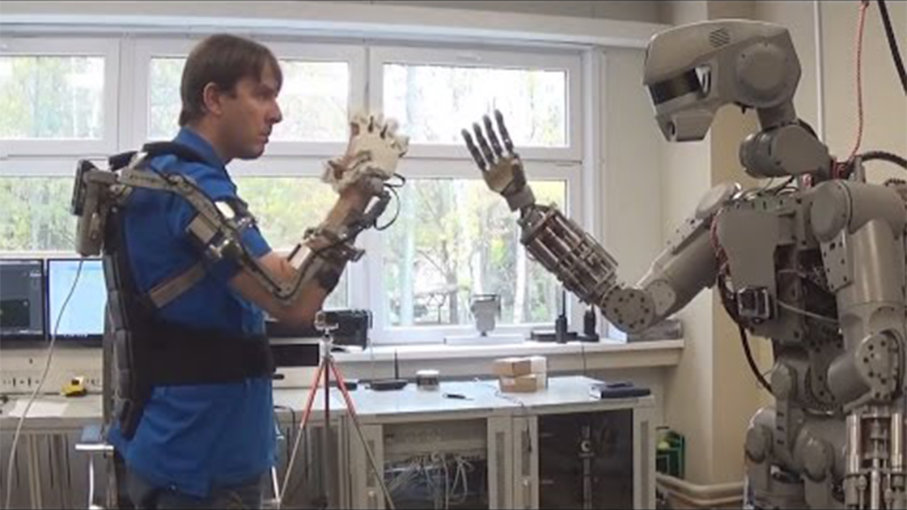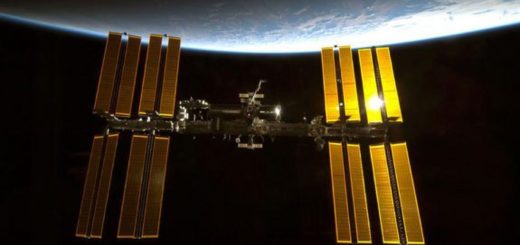Russia Sending Humanoid FEDOR Robot into Space

The Russians have been developing and testing the humanoid robot FEDOR, a version of which will be the sole occupant on the first launch of the new Russian spacecraft Federatsiya in 2022. SCREEN SHOT/YOUTUBE/HOWSTUFFWORKS
FEDOR, the Russian anthropomorphic robot, already has gotten a lot of attention by demonstrating its ability to fire handguns, do push-ups and even drive a car.
Now, the Russians apparently are preparing to send FEDOR into space. Russian news outlet RIA Novosti reported on July 20 that two FEDOR robots will be flown to the International Space Station next year, citing an unnamed rocket and space industry source.
The Russian news agency TASS subsequently reported on July 23 that a version of the robot, whose name stands for Final Experimental Demonstration Object Research, will be the sole occupant on the first launch of the new Russian spacecraft Federatsiya in 2022. The Federatsiya, which will replace Russia’s Soyuz-MS space vehicles, is envisioned as a vehicle for delivering humans and cargo to near-earth orbit and to the moon.
The Russian media reports didn’t detail what FEDOR actually might do in space, and Russia’s state space corporation, Roscosmos, has had no comment either. But robotics and space exploration experts in the west envision such androids as helpers who would handle simple tasks, freeing astronauts to do more complex work. Additionally, they imagine robots taking on jobs that are hazardous or physically grueling, such as venturing outside the spacecraft on extravehicular activity, or EVA, to perform repairs or deploy equipment. Eventually, such machines also could be useful on lunar or Mars colonization missions, though that may require adapting their form from human-like to something more resembling a four-legged animal.
The NASA Robonaut, R2
The Russians aren’t the only ones interested in developing anthropomorphic robots. For years, NASA has been developing its own “robonaut,” the R2, which was transported on the Space Shuttle Discovery to the ISS in February 2011. R2 originally was a torso-only humanoid, but a mobility platform was added in 2014, giving the robot a pair of legs as well. But the R2 developed a mysterious hardware glitch in 2015 that has rendered it inoperable for several years, and NASA finally decided in early 2018 to bring the robot back to Earth for repairs, according to technology publication IEEE Spectrum.
Samuel Bendett, a research analyst who follows Russian robotics at CNA, a nonprofit research and analysis organization based in Arlington, Va., says in an email that FEDOR was first developed in 2016 by Russia’s Foundation of Advanced Studies, that country’s equivalent of the Pentagon’s research arm, the Defense Advanced Research Projects Agency, or DARPA. It was envisioned as a multi-purpose robot for work in dangerous environments — such as places with chemical or radioactive contamination, and natural disasters — on Earth, as well as for use in space. Unlike simpler Russian robots and drones, the android is designed for jobs where multitasking is required, he said.
Video Player is loading.Pause
Unmute
Remaining Time –:-
Picture-in-Picture
Fullscreen
“As far as FEDOR’s humanoid appearance, a wide range of human activity in the future will have androids either replacing a person or become his reliable assistants,” Bendett writes. “So making FEDOR and similar future androids more human-like could facilitate the cooperative process between man and machine.”
Alex Ellery, an associate professor of mechanical and aerospace engineering at Canada’s Carleton University who worked on the European Space Agency’s ExoMars robotic rover, says that FEDOR, because of its complexity, faces some difficult challenges operating in space. Judging from photos, “it’s a pretty sophisticated kit,” he explains. “It probably will require significant amounts of power and computational support.” That could mean that FEDOR might have to spend much of its time tethered to the spacecraft’s electrical supply, rather than risk running down its battery.
Ellery also questions whether an android that emulates human anatomy was necessarily the most practical design for work in space. Human-like legs, for example, aren’t necessary to move around inside a spacecraft, he points out, though they might be useful for climbing on the outside during space walks. “Bipedal walking is a computationally difficult thing for robots to do — particularly if you want to do it stably,” he says.
Human-like hands, similarly, might not be an unneeded feature. “With a robot, you can take the hand out and replace it with a dedicated tool,” Ellery says.
Extravehicular Advantages
But Ellery envisions robonauts as having big advantages for tasks outside the spaceship. “EVA is dangerous for an astronaut, and takes a lot of preparation,” he notes. “But a machine like this simply could be put outside and told what it needed to do. There’s no time limit, like there would be with a human astronaut.”
Robert Zubrin, founder and president of the Mars Society, a Lakewood, Colorado-based organization that advocates exploration of the Red Planet, says that anthropomorphic robots could have some advantages in space exploration, because they could fit through the same doors and use the same tools as human astronauts. “The human design is a fairly efficient design,” he notes.
Zubrin envisions robots also being useful in extraterrestrial environments such as Mars. “A robot doesn’t have to put on a spacesuit to go outside,” he says. “You could keep the robot outside the habitat all the time, and ask it to go dust off the solar panels or do other tasks. Or if you’re traveling inside the pressurized rover, the robot could be on the running board, so that it can jump off and perform whatever tasks you need.”
Robots designed for use on Mars, however, might have four or six legs instead of two, so that they could have more stability on the planet’s rough terrain, Zubrin says.



 Creators of mankind
Creators of mankind Description of “Tall white aliens”
Description of “Tall white aliens” Where they came from?
Where they came from? About hostile civilizations
About hostile civilizations The war for the Earth
The war for the Earth “Tall white aliens” about eternal life
“Tall white aliens” about eternal life Video: “Nordic aliens”
Video: “Nordic aliens” Aliens
Aliens Alien encounters
Alien encounters The aliens base
The aliens base UFO
UFO Technology UFO
Technology UFO Underground civilization
Underground civilization Ancient alien artifacts
Ancient alien artifacts Military and UFO
Military and UFO Mysteries and hypotheses
Mysteries and hypotheses Scientific facts
Scientific facts


















